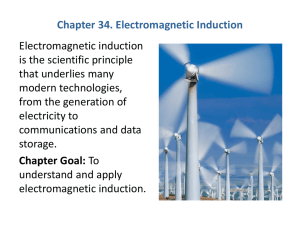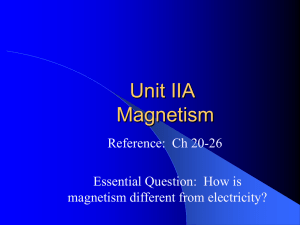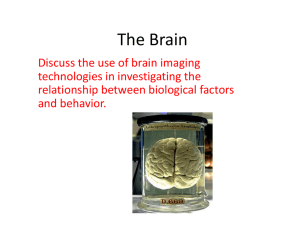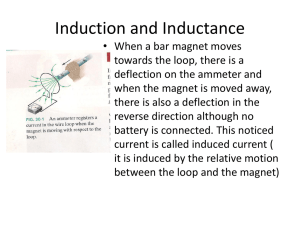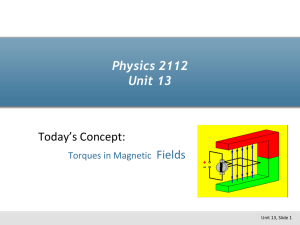Chapter 2 Describing Motion
advertisement
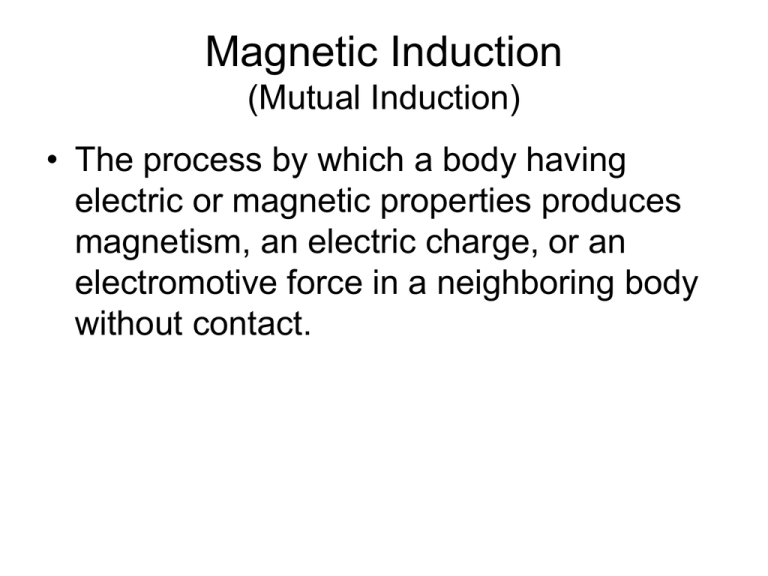
Magnetic Induction (Mutual Induction) • The process by which a body having electric or magnetic properties produces magnetism, an electric charge, or an electromotive force in a neighboring body without contact. Magnetic Induction A coil of wire is wrapped around a nail as shown in the top picture below. The bottom nail shows the alignment of the magnetic domains in the top nail. Watch what happens as the electrons flow through the coil of wire around the nail. The domains slowly realigned until they were all pointed in the same direction. The nail/wire coil combination has become and electromagnet (see next slide). What will happen when we reverse the current in the coil of wire? 13-8 The Electromagnetic An electromagnetic is a magnet that you can turn off and on. Moving electrons (current) generate electric fields which in turn generate magnetic fields. These magnetic fields cause the magnetic domains in the metal to align creating a magnet. When you open the switch, the domains realign themselves turning the magnet back into an ordinary piece of metal. 13-9 Alternating Current in Electromagnets When the current flows through the electromagnetic, it aligns the diploes in a certain direction. When the current direction is alternated, the diploes immediately switch directions. As a result, the magnetic poles of the electromagnet are switched. 13-15 Alternating Current in Electromagnets When the current flows through the electromagnetic, it aligns the diploes in a certain direction. When the current direction is alternated, the diploes immediately switch directions. As a result, the magnetic poles of the electromagnet are switched. 13-16 Magnetic Induction Realigning magnetic dipoles can also cause electrons to move. Flowing electrons from a power supply cause the domains in the vicinity of the first coil to align. These domains in turn induce the other domains in the nail to realign. Watch what happens to the electrons in the second coil and watch the light bulb as the magnetic domains in the vicinity of the second coil realign. As long as these domains were moving, electrons in the second coil moved causing the light to go on. Once the domains stop moving, the electrons stop moving, and the light goes out even though the electrons are still moving in the first coil. 13-17 Magnetism and Current Observe what happens when a magnet is passed through a conducting loop. While there was relative motion between the loop and the magnet there was current generated in the loop. What do you suppose would happen if we inserted the magnet faster? The faster the relative motion, the more current is generated within the loop. What do you suppose would happen if we inserted the South pole of the magnet first? Again, the current direction changed. Magnetism and Current Observe the behavior of the light bulbs and the ammeter below when the switch is closed and then opened. What happens when the switch is closed? Bulb one lit up, and bulb two blinked as the ammeter registered a counterclockwise current. What happens when the switch is opened? Bulb one goes out, and bulb two blinks again as the ammeter registers a clockwise current. Induced emf We discovered that a current through one loop established a current in a second parallel loop. The current established in the second loop only exists when the magnetic field in the first loop is changing. Once this magnetic field stabilizes (stops changing), the electrons in the second loop cease flowing and bulb 2 went out. In the first experiment we saw that we can induce a current when there is relative motion between the conducting electrons and the magnetic field. In this experiment we saw that the electrons moved when they experienced a changing magnetic field. Both experiments show a form of induced emf. Faraday’s Law of Induction • These experiments show examples of Faraday’s Law of Induction. • This law states that an emf is induced in a wire loop whenever the number of magnetic field lines passing through that loop changes. • This number of magnetic field lines, or the magnetic flux, changes when • There is relative motion between the conducting electrons • Whenever the magnetic field changes in the vicinity of these conducting electrons. Lenz’s Law Faraday’s Law enables us to calculate the emf produced between a conductor and a changing magnetic field. Lenz’s law is used to determine the direction of this induced emf. Lenz’s law states that the magnetic field generated by the induced current opposes the change in the magnetic field that created the induced current. If the magnetic field of the magnet is increasing then the magnetic field generated by the induced current acts to oppose this increase. If the magnetic field of the magnet is decreasing then the magnetic field generated by the induced current acts to oppose this decrease. BM BIC Induced emf • Magnetic flux is defined as the total number of magnetic field lines passing through an area enclosed by a loop. B B A • The Induced emf through a loop of wire is equal to the rate of change of magnetic flux. B N t • The negative sign means that the induced current which creates the emf is in a direction so that its magnetic field opposes the original change in flux. • There are three ways to induce a current: • Change B • Change I • Change ө Lenz’s Law – Magnetism and Current Is the current through the conducting ring below clockwise or counter clockwise when the magnet is inserted? Explain your answer. The magnet moves into the ring with its North pole first. As a result, the magnetic field impacting the ring acts out of the plane of the board. Therefore, the induced magnetic field acting against the magnetic field of the bar magnet must act into the board inside the ring and out of the board on the outside of the ring. Using our right hand rule, we see that the induced magnetic field within the ring can only be established by a clockwise current. Magnetism and Current What is the direction of the induced magnetic field in the front coil when the switched is closed? The battery would produce a clockwise current within the front loop. Would the magnetic field produced inside the front loop act into or out of the plane of the board? In which direction would the induced magnetic field in the back loop act? In which direction would the current flow through this back loop? I • In which direction is the current induced in the loop? S S N N pole moving toward the loop B Transformers • Transformers are used to step-up (increase) or to step-down • • • • • (decrease) AC voltages. In order to do so, they rely on changing magnetic fields. Transformers have primary and secondary coils of wire. As the magnetic field changes on the primary side, electrons will flow through the secondary side. Once the field stabilizes, secondary side current stops. For this reason transformers need AC. 13-18 Transformers Notice how the magnetic domains realign as the current changes direction. As long as the current alternates, the light bulb will stay on. 13-19


